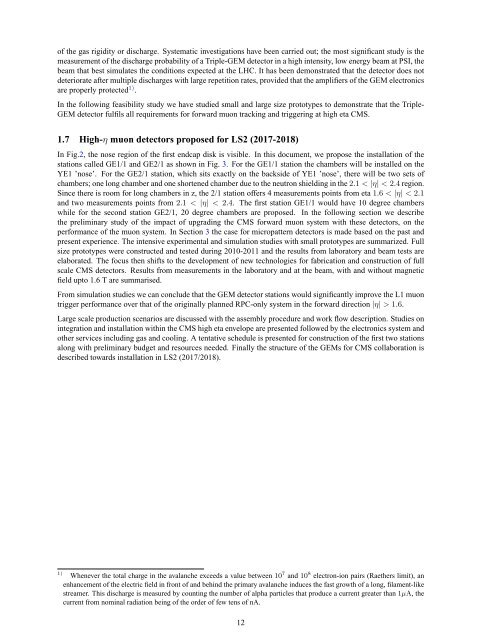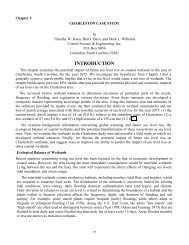A GEM Detector System for an Upgrade of the CMS Muon Endcaps
A GEM Detector System for an Upgrade of the CMS Muon Endcaps
A GEM Detector System for an Upgrade of the CMS Muon Endcaps
You also want an ePaper? Increase the reach of your titles
YUMPU automatically turns print PDFs into web optimized ePapers that Google loves.
<strong>of</strong> <strong>the</strong> gas rigidity or discharge. <strong>System</strong>atic investigations have been carried out; <strong>the</strong> most signific<strong>an</strong>t study is <strong>the</strong><br />
measurement <strong>of</strong> <strong>the</strong> discharge probability <strong>of</strong> a Triple-<strong>GEM</strong> detector in a high intensity, low energy beam at PSI, <strong>the</strong><br />
beam that best simulates <strong>the</strong> conditions expected at <strong>the</strong> LHC. It has been demonstrated that <strong>the</strong> detector does not<br />
deteriorate after multiple discharges with large repetition rates, provided that <strong>the</strong> amplifiers <strong>of</strong> <strong>the</strong> <strong>GEM</strong> electronics<br />
are properly protected 1) .<br />
In <strong>the</strong> following feasibility study we have studied small <strong>an</strong>d large size prototypes to demonstrate that <strong>the</strong> Triple-<br />
<strong>GEM</strong> detector fulfils all requirements <strong>for</strong> <strong>for</strong>ward muon tracking <strong>an</strong>d triggering at high eta <strong>CMS</strong>.<br />
1.7 High-η muon detectors proposed <strong>for</strong> LS2 (2017-2018)<br />
In Fig.2, <strong>the</strong> nose region <strong>of</strong> <strong>the</strong> first endcap disk is visible. In this document, we propose <strong>the</strong> installation <strong>of</strong> <strong>the</strong><br />
stations called GE1/1 <strong>an</strong>d GE2/1 as shown in Fig. 3. For <strong>the</strong> GE1/1 station <strong>the</strong> chambers will be installed on <strong>the</strong><br />
YE1 ’nose’. For <strong>the</strong> GE2/1 station, which sits exactly on <strong>the</strong> backside <strong>of</strong> YE1 ’nose’, <strong>the</strong>re will be two sets <strong>of</strong><br />
chambers; one long chamber <strong>an</strong>d one shortened chamber due to <strong>the</strong> neutron shielding in <strong>the</strong>2.1 < |η| < 2.4 region.<br />
Since <strong>the</strong>re is room <strong>for</strong> long chambers in z, <strong>the</strong> 2/1 station <strong>of</strong>fers 4 measurements points from eta 1.6 < |η| < 2.1<br />
<strong>an</strong>d two measurements points from 2.1 < |η| < 2.4. The first station GE1/1 would have 10 degree chambers<br />
while <strong>for</strong> <strong>the</strong> second station GE2/1, 20 degree chambers are proposed. In <strong>the</strong> following section we describe<br />
<strong>the</strong> preliminary study <strong>of</strong> <strong>the</strong> impact <strong>of</strong> upgrading <strong>the</strong> <strong>CMS</strong> <strong>for</strong>ward muon system with <strong>the</strong>se detectors, on <strong>the</strong><br />
per<strong>for</strong>m<strong>an</strong>ce <strong>of</strong> <strong>the</strong> muon system. In Section 3 <strong>the</strong> case <strong>for</strong> micropattern detectors is made based on <strong>the</strong> past <strong>an</strong>d<br />
present experience. The intensive experimental <strong>an</strong>d simulation studies with small prototypes are summarized. Full<br />
size prototypes were constructed <strong>an</strong>d tested during 2010-2011 <strong>an</strong>d <strong>the</strong> results from laboratory <strong>an</strong>d beam tests are<br />
elaborated. The focus <strong>the</strong>n shifts to <strong>the</strong> development <strong>of</strong> new technologies <strong>for</strong> fabrication <strong>an</strong>d construction <strong>of</strong> full<br />
scale <strong>CMS</strong> detectors. Results from measurements in <strong>the</strong> laboratory <strong>an</strong>d at <strong>the</strong> beam, with <strong>an</strong>d without magnetic<br />
field upto 1.6 T are summarised.<br />
From simulation studies we c<strong>an</strong> conclude that <strong>the</strong> <strong>GEM</strong> detector stations would signific<strong>an</strong>tly improve <strong>the</strong> L1 muon<br />
trigger per<strong>for</strong>m<strong>an</strong>ce over that <strong>of</strong> <strong>the</strong> originally pl<strong>an</strong>ned RPC-only system in <strong>the</strong> <strong>for</strong>ward direction |η| > 1.6.<br />
Large scale production scenarios are discussed with <strong>the</strong> assembly procedure <strong>an</strong>d work flow description. Studies on<br />
integration <strong>an</strong>d installation within <strong>the</strong> <strong>CMS</strong> high eta envelope are presented followed by <strong>the</strong> electronics system <strong>an</strong>d<br />
o<strong>the</strong>r services including gas <strong>an</strong>d cooling. A tentative schedule is presented <strong>for</strong> construction <strong>of</strong> <strong>the</strong> first two stations<br />
along with preliminary budget <strong>an</strong>d resources needed. Finally <strong>the</strong> structure <strong>of</strong> <strong>the</strong> <strong>GEM</strong>s <strong>for</strong> <strong>CMS</strong> collaboration is<br />
described towards installation in LS2 (2017/2018).<br />
1) Whenever <strong>the</strong> total charge in <strong>the</strong> aval<strong>an</strong>che exceeds a value between 10 7 <strong>an</strong>d 10 8 electron-ion pairs (Rae<strong>the</strong>rs limit), <strong>an</strong><br />
enh<strong>an</strong>cement <strong>of</strong> <strong>the</strong> electric field in front <strong>of</strong> <strong>an</strong>d behind <strong>the</strong> primary aval<strong>an</strong>che induces <strong>the</strong> fast growth <strong>of</strong> a long, filament-like<br />
streamer. This discharge is measured by counting <strong>the</strong> number <strong>of</strong> alpha particles that produce a current greater th<strong>an</strong> 1µA, <strong>the</strong><br />
current from nominal radiation being <strong>of</strong> <strong>the</strong> order <strong>of</strong> few tens <strong>of</strong> nA.<br />
12
















